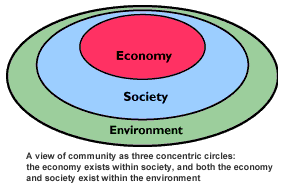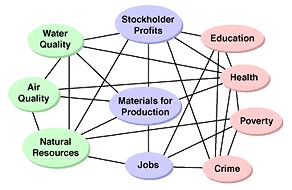Defining
and measuring sustainability in coastal Georgia:
Where are we headed?
Considering the term "Sustainability"
Over the past decade, you may have
heard the term "sustainable" used in many different contexts, but what
does it really mean? How can we tell if your community or coastal
Georgia as a region is sustainable, and if growth is moving us toward or
away from more responsible actions? Sustainability is not only based on
how we use our environment, but it is also related to our quality of
life - whether the economic, social and environmental systems that make
up the community are supporting a healthy, balanced, and fulfilling life
for residents, including both present and future generations. To be
sustainable, our way of life must retain the vital capacity of natural
systems so that we at least "do no harm" as we pass on the region's
quality of life to our children and their descendents.
How has the
quality of life in coastal Georgia changed over the last 20 or 40 years,
and what are the prospects for our future? These questions need to be
considered in the context of current conditions and emerging trends
(from local to global) using a reasonably objective set of measures.
One
way of depicting a sustainable community is shown in the diagram below:
 A view of community as three concentric circles: the economy exists
within society, and both the economy and society exist within the
environment
As this figure illustrates, the economy exists entirely within society,
because all parts of the human economy require interaction among people.
However, society is much more than just the economy. Friends and
families, music and art, religion and ethics are important elements of
society, but are not primarily based on exchanging goods and services.
A view of community as three concentric circles: the economy exists
within society, and both the economy and society exist within the
environment
As this figure illustrates, the economy exists entirely within society,
because all parts of the human economy require interaction among people.
However, society is much more than just the economy. Friends and
families, music and art, religion and ethics are important elements of
society, but are not primarily based on exchanging goods and services.
Society, in turn, exists entirely within the environment. Our basic
requirements - air, food and water - come from the environment, as do
the energy and raw materials for housing, transportation and the
products we depend on.
Finally, the environment surrounds society. At an earlier point in human
history, the environment largely determined the shape of society. Today
the opposite is true: human activity is reshaping the environment at an
ever-increasing rate. The parts of the environment unaffected by human
activity are getting smaller all the time. However, because people need
food, water and air to survive, society can never be larger than the
environment - and we cannot afford to neglect it, especially with a
growing population.
Furthermore, decisions about the economy and society
that are made without responsible understanding about their
environmental implications often produce conditions that are not
sustainable. Unsustainable uses of water, land, and air may produce
short-term profits and support jobs, but in the long-term they will
result in a declining quality of life, if not catastrophic events like
fish kills or major floods.
For example, housing and industrial
development may be provided in ways that reduce water quality. Until
the cumulative effects of decreasing water quality produce intolerable
conditions, there may be a misperception that current policies are
maintaining or improving quality of life.
In the meantime we cause
costly avoidable damage.
There are already several troubling indications
that current policies are not working in Georgia generally, and along
the coast in particular (see chart below).
Sustainability requires
managing all activities - individual, community, national, and global
in ways that ensure that our economy and society can continue to exist
without destroying the natural environment on which we all depend. To
become more sustainable, communities must realize that there are limits
to the natural, social and built systems upon which we depend. Key
questions asked when analyzing our sustainability include: "Are we using
natural resources faster than they can be renewed" and "Are we advancing
the social values and human qualities that we seek to cultivate in our
region?"
Although complete sustainability may be very difficult to achieve, it is
a worthy goal that can be used in guiding public policies and private
practices to make our use of the environment more responsible. Likewise,
it can help improve the effectiveness of policies intended to serve
public interest - thereby reducing the cost of programs that currently
work against one another. For example, poorly planned economic
development efforts may reduce environmental quality and cause the loss
of jobs dependent on natural resources - like eco-tourism and fishing.
Therefore it is very important to find ways to measure and strengthen
coastal Georgia's long-range economic, environmental, and social
sustainability. Until this is done, important decisions about
activities that use land, air and water will be made without knowing the
consequences, producing still more unwanted outcomes. And attempts to
reach one objective, such as income generation, will be likely to
contradict another one, like environmental quality.
The distribution of
adverse outcomes may also be an issue, since higher-income households
may be able to escape some of the most undesirable conditions. Thus,
toxic contamination from industrial pollution is typically a greater
risk in low-income neighborhoods. Over time, however, many
environmental risks have become systemic, reaching all income groups, so
that improving sustainability will provide near-universal benefits.
Measuring Sustainability
An indicator is something that helps you
understand where you are, which way you are going and how far you are
from where you want to be. A good indicator alerts you to a problem
before it gets too bad and helps you recognize what needs to be done to
fix the problem. Indicators of a sustainable community point to areas
where the links between the economy, environment and society are weak.
They allow you to see where the problem areas are and help reveal workable alternatives
for fixing those problems.
Traditional indicators of
economic, environmental, and social progress were almost always used
independent of one another. When considered in isolation, they measure
changes in one part of a community or region as if they were entirely
independent of the other parts. To make more effective decisions that
produce greater sustainability, indicators must reflect the reality that
the three different segments of our world are highly interconnected and
interdependent, as shown in the figure below.

As this figure illustrates, the natural resource base provides the
materials for production on which jobs and stockholder profits depend.
Jobs (and wages) affect the poverty rate, and the poverty rate is
related to crime. Air quality, water quality and materials used for
production are obviously related to human health. They may also have an
effect on stockholder profits - for example, if a business requires
clean water, cleaning up poor quality water prior to processing is an
extra expense, which reduces profits. Likewise, health problems,
whether due to reduced quality of air and water or exposure to toxic
materials, can harm worker productivity, contribute to the rising costs
of health insurance, impair lives, and shorten lifespan.
Sustainability
requires this type of integrated view of the world - and to evaluate it
requires multi-dimensional indicators that show the links among the
region's economy, environment, and society. For example, the Gross
Domestic Product (GDP), a well-publicized national indicator, measures
the volume of commerce being generated in a country. It is generally
reported as a measure of the country's economic well-being-the more
money being spent, the higher the GDP and the better the overall
economic well-being is assumed to be. However, because GDP reflects only
the amount of economic activity, regardless of its origins or effects on
the citizens' social and environmental health, GDP can go up when
overall public benefits are declining.
Likewise, when there is a 10-car
accident on the highway, the GDP goes up because of the money spent on
medical fees and repair costs. On the other hand, if ten people decide
not to buy cars and instead walk to work, their health and wealth may
increase but the GDP goes down. More to the point, when damage to
natural resources must be corrected due to the impacts of inadequately
planned development (assuming environmental restoration is even
possible), the cost of doing that would contribute to the GDP, instead
of that damage being treated as something to be avoided. Similarly,
when we pay medical bills for health problems caused by contaminated air
or water, these expenses are counted as if they are desirable because
they add to measured economic activity.
From these examples and the
overview presented in the box below, it is evident that we must adopt
sustainability indicators to be used in guiding key decisions if we hope
to safeguard our cherished quality of life as the region's growth
continues. Lacking effective measures of sustainability, we'll drift
toward declining environmental, economic, and social conditions because
we simply do not understand the cumulative consequences of our actions.
Our future depends on doing a better job of tracking where we are
headed and using reliable measures of sustainability to help chart our
course.
Selected indicators for measuring sustainability in Coastal Georgia
- Proportion of impaired waters (over 60% of Georgia's waterways are impaired by federal standards)
- Number of fish consumption advisories (half of Georgia's known contaminated fish are on the coast)
- Volume and composition of toxic chemicals (in 2004, 3.9 million lbs. released in just 2 coastal counties)
- Fishery diversity and landings (blue crab plummeting, sturgeon fishery closed, shad fishery nearly gone)
- Number of enforcement officials (State & local budgeting falls far short of identified needs, including clean-up)
- Average water use per capita (studies statewide show excessive waste, worse than national averages)
|
|